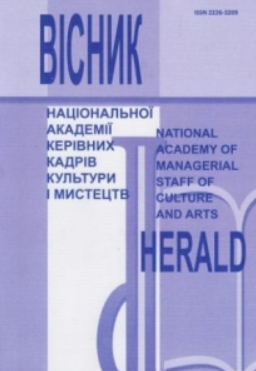КУРТУАЗНІ МОТИВИ У МИСТЕЦТВІ ВИСОКОГО СЕРЕДНЬОВІЧЧЯ
COURTLY MOTIVES IN THE ART OF THE HIGH MIDDLE AGES
Author(s): Alina Slivinska, Larysa TzvetkovaSubject(s): Cultural history, Visual Arts, 13th to 14th Centuries, 15th Century, History of Art
Published by: Національна академія керівних кадрів культури і мистецтв
Keywords: courtesy; art; Middle Ages; chivalry; heraldry;
Summary/Abstract: Purpose of the article. The article presents a study of courtly motives in the art of the high Middle Ages and the foundations of the ideological and figurative-symbolic representation of courtly images in various artistic forms of this era. Methodology. The study of the content of courtly motives and images, the definition of the ideological foundations of their figurative and symbolic representation was carried out through the use of historical, analytical, symbolic, and allegorical methods. Scientific novelty. The article examines courtly motives and courtly images presented in the art of the High Middle Ages, identifies the ideological foundations of their figurative and symbolic representation in various artistic forms of this era. Conclusions. The visual images of medieval masters create the world of courtly, filling the courtly universe with numerous subjects that reflect the image and lifestyle of both knights and their Beautiful ladies. And thus they help to understand the norms and prescriptions of courtesy, the models of the participants' behavior in the courteous action, the corresponding rituals and etiquette norms of courteous relations, their attributes, and stylistics. In order to do this, the artists used various techniques - bright colors, saturation with symbols, heraldry, outfits, etc. Especially popular was the use of the rose image, which became the quintessence of Gothic art, its courtly and religious symbol, the embodiment of the ideal of chivalry to the Beautiful Lady, and a kind of reflection of the Christian image of the Virgin Mary.
Journal: Вісник Національної академії керівних кадрів культури і мистецтв
- Issue Year: 2021
- Issue No: 1
- Page Range: 71-75
- Page Count: 5
- Language: Ukrainian

